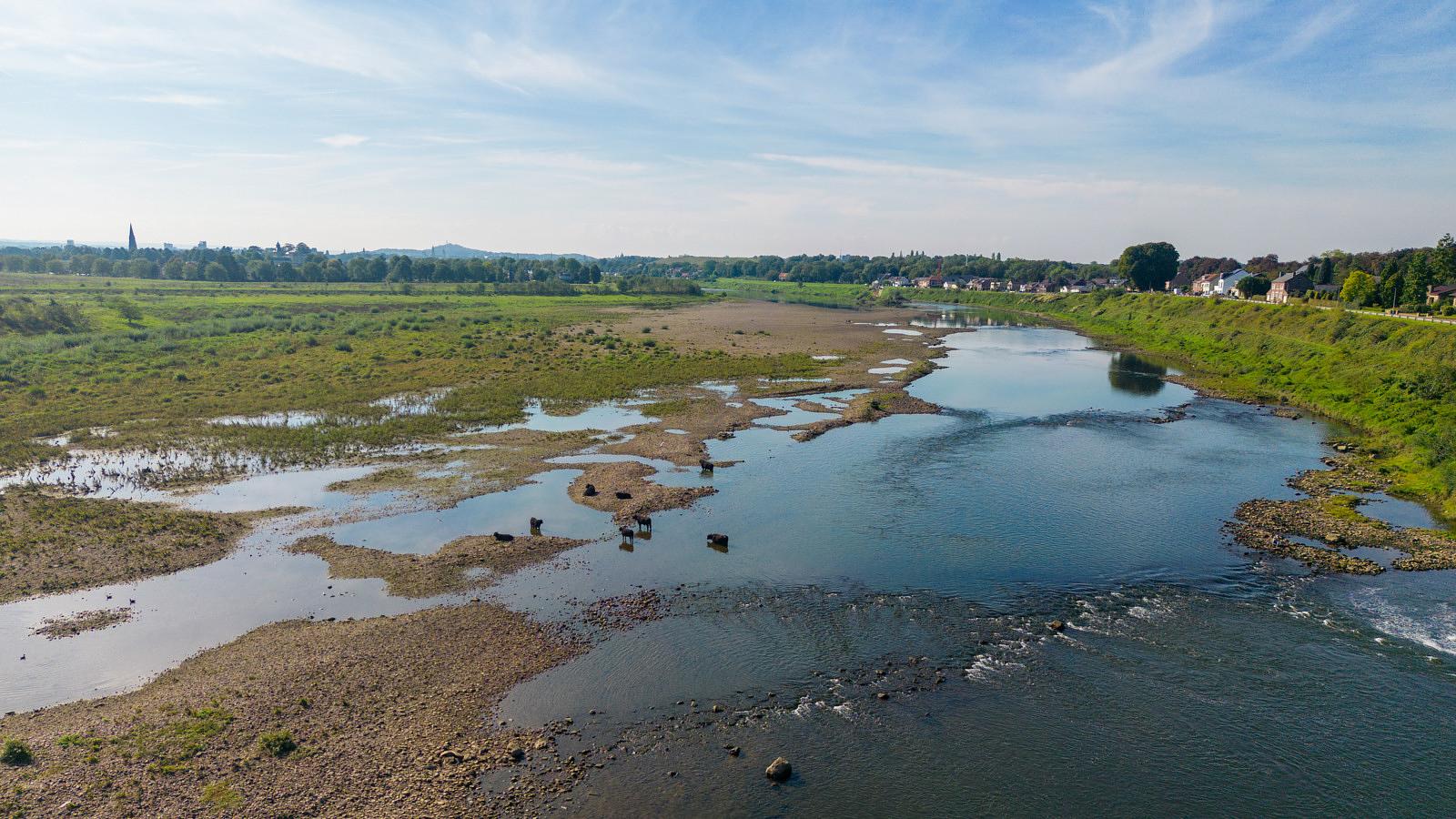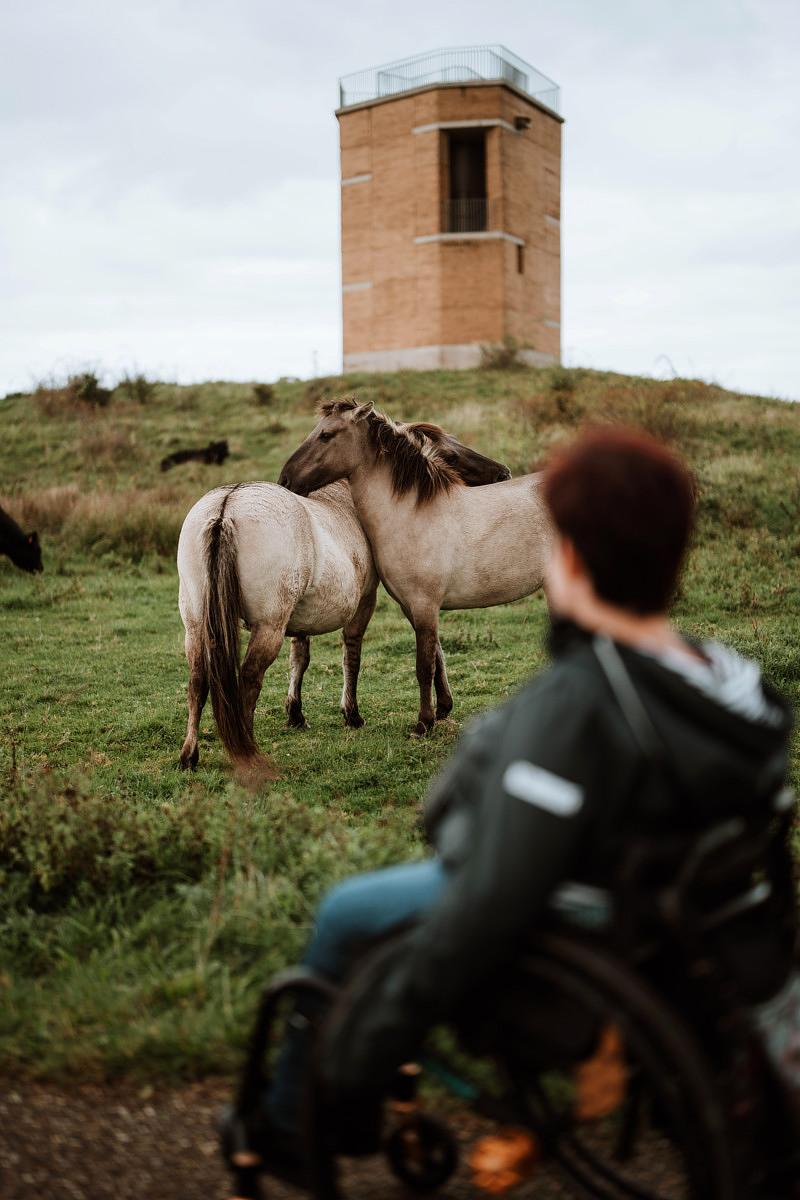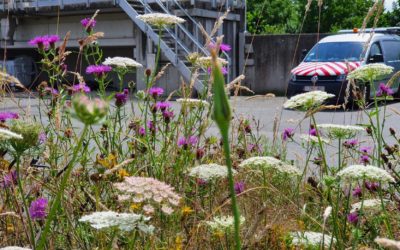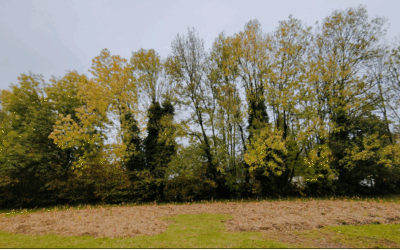Local approach to biodiversity at Aquafin’s wastewater treatment plant sites.
The Meuse Valley River Park
The project
The Maas Valley River Park stretches along both banks of the Meuse between Maastricht and Maasbracht, where it also forms the border between Belgium and the Netherlands. This section of the river is highly dynamic, has remained unregulated and is largely unnavigable. After floods in 1993 and 1995, large-scale widening works and ecological restoration were carried out. Today, the Maas Valley River Park contains 22 different nature reserves, most of which are grazed by Konik horses and Galloway cattle. The water-rich nature reserves near the river form a unique habitat for numerous species, with flora and (water) birds being particularly noteworthy. The area is dotted with Meuse villages on both sides, some of which are still connected by a ferry. Landscape and nature experience, combined with the disclosure of the rich cultural history, are also important goals for the area coalition. Since 2023, this area has been recognised as a (cross-border) Landscape Park.

Project location
Contribution(s)
Project costs
Participant(s)

- Regionaal Landschap Kempen en Maasland vzw is responsible for the development of the Maas Valley River Park. To this end, it has put together a BE-NL team and separate analytical accounts.
- Nature conservation organisations (Natuurpunt, Natuurmonumenten, Limburgs Landschap and Staatsbosbeheer).
- Municipal authorities (Kinrooi, Maaseik, Dilsen-Stokkem, Maasmechelen, Lanaken, Maastricht, Meerssen, Stein, Sittard-Geleen, Echt-Susteren and Maasgouw) and both Provinces of Limburg (BE and NL) each contribute through an annual subsidy.
- Tourist organisations: Visit Limburg, Visit Zuid-Limburg and VVV Midden-Limburg.
- Agencies of the Flemish government: VLM, ANB, Onroerend Erfgoed, Toerisme Vlaanderen, Dep. Omgeving and VMM, with a special mention for De Vlaamse Waterweg as manager of the Meuse. Agencies of the Dutch government: Rijkswaterstaat (counterpart of De Vlaamse Waterweg), Waterschap. The Maas Valley River Park receives an annual subsidy via the VLM. De Vlaamse Waterweg also contributes to specific actions related to river management.
How are the criteria of the objective met?
Urban and peri-urban areas
- Respect and/or improve the specific ecological characteristics of the area (e.g. the topography, the type of landscape, the local plant and animal life);
- Set up a biodiversity-friendly management system (e.g. rewilding, reduced mowing of parks, gardens, talus, ponds, no chemicals);
- As much naturalness as possible/as little alteration as possible of the initial landscape (landscape, quality of water, of soil, …);
- Incorporate the developments into the surrounding area and environment;
- Use native species/subspecies that are more resilient and resistant to climate change, if appropriate.
The Master Plan for the Meuse Valley River Park (2024-2049) and the current Operational Plan (2024-2029) include objectives to develop additional dynamic river nature, to soften and green village centres, to contribute to transnational nature connections via the winter bed of the Meuse, to facilitate scientific research, to remove plastic from the river, etc.
Possible initiatives in which the project is involved :

Long-term maintenance
The Master Plan for the Maas Valley River Park, endorsed by the four nature conservation organisations on both banks (Natuurpunt, Natuurmonumenten, Limburgs Landschap and Staatsbosbeheer), describes the joint nature conservation objectives. The processes of “river dynamics” and “year-round grazing” are leading, with only minimal adjustments. Long-term management is guaranteed through nature management plans.
Benefits
The river widening and restoration projects, together with the associated nature development that is still ongoing in the Maas Valley River Park, ensured that residents came through the 2021 floods unscathed. In a study, Hasselt University previously calculated the economic benefits of the river redevelopment: 19 to 22 million per year in terms of damage prevention, ecosystem services and landscape experience/tourism.
Thanks to river restoration, the area of nature has doubled in the last 15 years, after nature values had taken a nosedive in the 20th century (along with the water quality of the Meuse). Biodiversity in the flora tripled on those approximately 2,100 hectares of nature.
In short, the results of restoration, but also of minimal human intervention, are spectacular. However, biodiversity in the water remains a major challenge due to problems at the level of the entire river basin.
Other projects linked to the objective: "Urban and peri-urban areas"
Micro-forests
UrbanForests specialises in creating participatory micro-forests that are 100% natural and based on the Miyawaki method.
Mini forest in Josephine Koch Park
1 day, 900 trees & many hands for greater biodiversity & climate protection.


